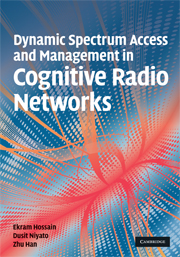Book contents
- Frontmatter
- Contents
- Preface
- Part I Introduction
- Part II Techniques for design, analysis, and optimization of dynamic spectrum access and management
- 3 Signal processing techniques
- 4 Optimization techniques
- 5 Game theory
- 6 Intelligent algorithms
- Part III Dynamic spectrum access and management
- References
- Index
3 - Signal processing techniques
from Part II - Techniques for design, analysis, and optimization of dynamic spectrum access and management
Published online by Cambridge University Press: 26 February 2010
- Frontmatter
- Contents
- Preface
- Part I Introduction
- Part II Techniques for design, analysis, and optimization of dynamic spectrum access and management
- 3 Signal processing techniques
- 4 Optimization techniques
- 5 Game theory
- 6 Intelligent algorithms
- Part III Dynamic spectrum access and management
- References
- Index
Summary
Signal processing deals with the analysis, interpretation, and manipulation of signals. Signals of interest include sound, images, biological signals, radar signals, and many others. Processing of such signals includes filtering, storage and reconstruction, separation of information from noise (e.g. aircraft identification by radar), compression (e.g. image compression), and feature extraction (e.g. speech-to-text conversion). In communications systems, signal processing is mostly performed at OSI layer 1, the physical layer (modulation, equalization, multiplexing, radio transmission, etc.), as well as at OSI layer 6, the presentation layer (source coding, including analog-to-digital conversion, and data compression). In cognitive radio networks, the major task of signal processing is spectrum sensing for detecting the unused spectrum and sharing it without harmful interference to other users. One important requirement in a cognitive radio network is sensing spectrum holes reliably and efficiently. Spectrum sensing techniques can be classified into three categories. First, cognitive radios must be capable of determining if a signal from a primary transmitter is locally present in a certain spectrum. Several approaches are used for transmitter detection, such as matched filter detection, energy detection, cyclostationary feature detection, and wavelet detection. Second, collaborative detection refers to spectrum sensing methods where information from multiple cognitive radio users is exploited for primary user detection. Third, the sensing devices can be separated from the secondary users and can be deployed into the cognitive network by the cognitive radio service provider. By doing this, the cost of the secondary user devices can be reduced and the hidden terminal problem/exposed terminal problem can be mitigated.
Information
- Type
- Chapter
- Information
- Publisher: Cambridge University PressPrint publication year: 2009
